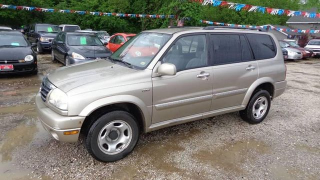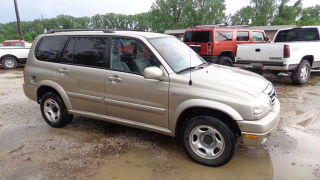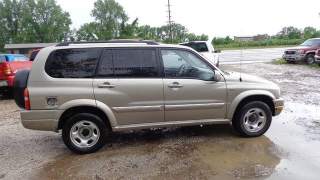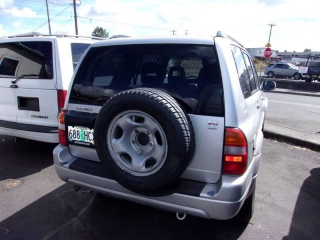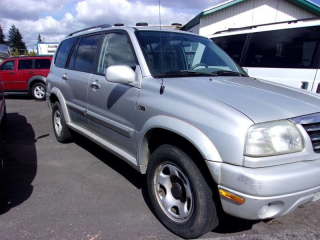The 2002 Suzuki XL7 is a compact SUV that offered a practical and affordable option for families. It was produced from 2001 to 2006, with key trims often including base and Premium models. What made it stand out was its combination of car-like handling and SUV versatility, often at a more accessible price point than some of its rivals, making it a popular choice for value-conscious buyers.
The Good
The 2002 Suzuki XL7 offers a compelling blend of practicality and value. Its nimble handling and decent fuel economy appeal to the practical buyer, while its surprisingly spacious interior and capable performance provide emotional reassurance for family adventures.
The Bad
Potential buyers of the 2002 Suzuki XL7 should be aware of common issues such as premature catalytic converter failure and potential transmission problems. Interior materials may also show wear and tear, and rust can be a concern in certain climates.
2002 Suzuki XL7: Quick Overview
- Engine Options: The 2002 Suzuki XL7 was exclusively offered with a 2.7-liter V6 engine.
- Horsepower: This V6 engine produced approximately 170 horsepower.
- Fuel Economy: EPA estimates for the 2002 XL7 were around 17 MPG city and 22 MPG highway.
- 0-60 Times: Acceleration was modest, with 0-60 mph times typically in the range of 9.5 to 10.5 seconds, depending on drivetrain and load.
- Towing Capacity: The towing capacity for the 2002 XL7 was generally rated at around 3,500 pounds, making it suitable for light trailers or small boats.
- Trim-Level Features:
- Base Trim: Typically included essentials like power windows and locks, air conditioning, a CD player, and cloth upholstery. It was often available in either two-wheel drive (2WD) or four-wheel drive (4WD).
- Premium Trim: This higher trim level usually added features such as leather-trimmed seats, a power-adjustable driver's seat, alloy wheels, a sunroof, and an upgraded audio system. Some Premium models might have also included a roof rack and side steps.
- Common Features across Trims: Anti-lock brakes (ABS), dual front airbags, and side-impact door beams were standard safety features. Many models also came equipped with cruise control and intermittent windshield wipers. Optional features could include a rear-seat entertainment system or a premium sound system from brands like Bose in higher trims.
2002 Suzuki XL7 Specifications
Vehicle Information
| Year | 2002 |
| Make | Suzuki |
| Model | XL7 |
| Trim | - |
| Style | 4WD |
| Type | Sport Utility Vehicle |
| Category | Standard Sport Utility Vehicle |
Manufacturing Details
| Made In | Japan |
| Manufacturing City | IWATA |
Dimensions
| Doors | 4-Door |
| Curb Weight | 3715 pounds |
| Gross Vehicle Weight Rating | 4916 pounds |
| Overall Height | 68.00 inches |
| Overall Length | 183.60 inches |
| Overall Width | 70.10 inches |
| Wheelbase Length | 110.20 inches |
| Standard Seating | 7 |
Engine & Performance
| Engine | 2.7-L V-6 DOHC 24V |
| Engine Size | 2.7L |
| Engine Cylinders | 6 |
| Transmission | 4-Speed Automatic |
| Transmission Type | Automatic |
| Transmission Speeds | 4-Speed |
| Drivetrain | Four-Wheel Drive |
Additional Features
| Anti-Brake System | 4-Wheel ABS |
| Steering Type | Rack & Pinion |
Pricing
| Manufacturer Suggested Retail Price (MSRP) | $25,999 |
| Invoice Price | $23,919 |
| Delivery Charges | $520 |
Vehicle History Report
Vehicle
Specifications
Specifications
Ownership
History
History
All History
Events
Events
NMVTIS Title
History Check
History Check
Salvage/Rebuilt
Check
Check
Accident
Check
Check
Theft
Check
Check
Open Lien
Check
Check
Past Sale
Listings
Listings
Safety
Recalls
Recalls
Odometer
Check
Check
Market Price
Analysis
Analysis
What Problems Does the 2002 Suzuki XL7 Have?
The 2002 Suzuki XL7, while generally considered a decent value, is not without its common issues that owners frequently report. One of the most prevalent and costly problems involves the catalytic converter. Many owners have experienced premature failure of this component, often leading to a significant drop in performance and check engine lights. This issue seems to affect various model years of the XL7, including the 2002.
Another area of concern is the transmission. While not as universal as catalytic converter issues, some owners have reported instances of premature transmission failure or rough shifting, particularly as the vehicle ages and accumulates mileage. This can manifest as slipping gears or a complete loss of drive.
The ignition system can also be a source of trouble. Spark plug and coil pack failures have been noted, leading to misfires and rough running. This can sometimes be mistaken for other engine issues, so a thorough diagnosis is important.
Interior wear and tear is also a common observation, with upholstery sometimes showing signs of premature aging and plastic trim pieces becoming brittle.
Regarding recalls, it's always advisable to check the National Highway Traffic Safety Administration (NHTSA) website for any outstanding recalls specific to the 2002 Suzuki XL7 VIN. Recalls can address safety-critical issues and should be addressed by a qualified mechanic.
In terms of long-term reliability, the Suzuki XL7 can be a reliable vehicle if well-maintained. However, the potential for these more significant repair costs, such as catalytic converter and transmission issues, can impact its overall long-term ownership experience and make it less reliable than some competitors if these problems arise.
Another area of concern is the transmission. While not as universal as catalytic converter issues, some owners have reported instances of premature transmission failure or rough shifting, particularly as the vehicle ages and accumulates mileage. This can manifest as slipping gears or a complete loss of drive.
The ignition system can also be a source of trouble. Spark plug and coil pack failures have been noted, leading to misfires and rough running. This can sometimes be mistaken for other engine issues, so a thorough diagnosis is important.
Interior wear and tear is also a common observation, with upholstery sometimes showing signs of premature aging and plastic trim pieces becoming brittle.
Regarding recalls, it's always advisable to check the National Highway Traffic Safety Administration (NHTSA) website for any outstanding recalls specific to the 2002 Suzuki XL7 VIN. Recalls can address safety-critical issues and should be addressed by a qualified mechanic.
In terms of long-term reliability, the Suzuki XL7 can be a reliable vehicle if well-maintained. However, the potential for these more significant repair costs, such as catalytic converter and transmission issues, can impact its overall long-term ownership experience and make it less reliable than some competitors if these problems arise.
How long will the 2002 Suzuki XL7 last?
Based on owner data and common maintenance practices, the 2002 Suzuki XL7 can realistically achieve an average mileage of 150,000 to 200,000 miles, with some examples exceeding 250,000 miles with diligent care. Long-term durability is significantly influenced by consistent oil changes, timely replacement of wear items like belts and hoses, and addressing known issues promptly. The V6 engine itself is generally robust. However, weaknesses like potential catalytic converter failure and transmission issues can emerge around the 100,000 to 150,000-mile mark, potentially limiting its service life if repairs are not undertaken. Rust can also become a factor in humid or road-salt-prone regions, affecting structural integrity over time.
What Technology & Safety Features are Included?
The 2002 Suzuki XL7 offers a functional, though not cutting-edge, array of technology, entertainment, and safety features for its era. In terms of built-in tech, standard equipment often included a basic AM/FM stereo with a CD player, providing straightforward audio playback. Power windows and power door locks were common, enhancing convenience. Air conditioning was standard across most trims.
Entertainment options in higher trims or as optional packages could include a premium sound system with more speakers, offering a slightly more immersive listening experience. Some models might have been equipped with a rear-seat entertainment system, a feature that was gaining popularity in SUVs at the time, though this was less common.
Driver-assistance features were quite limited by today's standards. Cruise control was a standard convenience feature on most models. Features like parking sensors or a rearview camera were not available.
Safety was addressed with a focus on passive safety. Standard safety equipment included dual front airbags and anti-lock brakes (ABS), which were crucial for maintaining steering control during emergency braking. Side-impact door beams were also incorporated to enhance occupant protection in side collisions.
Crash-test ratings for the 2002 Suzuki XL7 are available from the National Highway Traffic Safety Administration (NHTSA). For the front driver and passenger side impact tests, it generally received good ratings, often achieving 4 or 5 stars, indicating strong performance in absorbing impact energy. Side impact ratings were also typically favorable. However, rollover resistance ratings for SUVs of this era were not as robust as modern vehicles. It's always recommended to consult the NHTSA website for the most precise and up-to-date crash-test data for the specific model year.
Entertainment options in higher trims or as optional packages could include a premium sound system with more speakers, offering a slightly more immersive listening experience. Some models might have been equipped with a rear-seat entertainment system, a feature that was gaining popularity in SUVs at the time, though this was less common.
Driver-assistance features were quite limited by today's standards. Cruise control was a standard convenience feature on most models. Features like parking sensors or a rearview camera were not available.
Safety was addressed with a focus on passive safety. Standard safety equipment included dual front airbags and anti-lock brakes (ABS), which were crucial for maintaining steering control during emergency braking. Side-impact door beams were also incorporated to enhance occupant protection in side collisions.
Crash-test ratings for the 2002 Suzuki XL7 are available from the National Highway Traffic Safety Administration (NHTSA). For the front driver and passenger side impact tests, it generally received good ratings, often achieving 4 or 5 stars, indicating strong performance in absorbing impact energy. Side impact ratings were also typically favorable. However, rollover resistance ratings for SUVs of this era were not as robust as modern vehicles. It's always recommended to consult the NHTSA website for the most precise and up-to-date crash-test data for the specific model year.
What Colors Options are Available?
2002 Suzuki XL7 Prices and Market Value
When new, the 2002 Suzuki XL7 had an original MSRP ranging from approximately $20,000 for base models to around $25,000 for higher trim levels. As a used vehicle today, the 2002 XL7 typically falls into the budget-friendly category. Prices can range from as low as $1,500 to $4,000, heavily dependent on mileage, condition, and trim. The vehicle has experienced significant depreciation, which is typical for SUVs of this age. Factors affecting its current resale value include its overall condition, maintenance history, the presence of rust, and the number of existing issues. Models with lower mileage and a documented service history will command higher prices. Its popularity as an affordable, functional SUV in certain markets can help maintain a modest resale value, but significant repairs can drastically reduce it.
2002 Suzuki XL7 Cost of Ownership
The 2002 Suzuki XL7 is generally considered economical to own, especially considering its initial purchase price. Insurance costs are typically moderate, falling in line with other compact SUVs of its era. Fuel costs are also reasonable, with its V6 engine offering decent MPG for its class. Maintenance costs are average for a vehicle of this age, with regular oil changes and fluid checks being essential. However, potential repair costs can be a significant factor. Known issues like catalytic converter or transmission problems can be expensive to fix, pushing up the overall cost of ownership if they arise. Therefore, while it can be economical, be prepared for potential higher repair bills.
2002 Suzuki XL7 Fuel Efficiency
Fuel Type
Gasoline
Fuel Capacity
16.90 gallons
City Mileage
17 miles/gallon
Highway Mileage
20 miles/gallon
2002 Suzuki XL7 Safety Rating
NHTSA
IIHS
2002 Suzuki XL7 Warranty
Basic
Original warranty
36 months / 36,000 miles
Estimated remaining
Expired
Powertrain
Original warranty
36 months / 36,000 miles
Estimated remaining
Expired
Rust
Original warranty
36 months / unlimited miles
Estimated remaining
Expired
2002 Suzuki XL7 Insurance
Insurance for a 2002 Suzuki XL7 is moderately priced, reflecting its status as a Sport Utility Vehicle with strong safety ratings and
reasonable repair costs.
reasonable repair costs.
How Does the 2002 Suzuki XL7 Compare to Other Sport Utility Vehicle?
The 2002 Suzuki XL7 entered a competitive compact SUV segment. In terms of performance, its 170-horsepower V6 was competitive, offering adequate acceleration, though not sportier than rivals like the Honda CR-V or Toyota RAV4, which often featured refined 4-cylinder engines. However, the XL7's available V6 gave it a slight edge in towing capacity, often reaching 3,500 lbs, whereas many 4-cylinder competitors topped out around 1,500 lbs.
Features-wise, the XL7 offered a solid package for its price point. While base models were utilitarian, higher trims offered leather, power seats, and sunroofs, aligning it with competitors like the Ford Escape or Mazda Tribute. However, it generally lagged behind more premium offerings like the Lexus RX in terms of advanced tech or luxury materials.
Reliability is where the XL7 faced its biggest challenges compared to class leaders. While the engine itself could be durable with proper care, common issues like catalytic converter and transmission problems were more frequently reported than with the highly dependable Honda CR-V or Toyota RAV4. These reliability concerns often impacted its long-term ownership costs.
Price was a strong suit for the Suzuki XL7. It was typically priced more affordably than the Honda CR-V, Toyota RAV4, or even the Ford Escape when new, and this value proposition continues in the used market.
Alternatives:
Features-wise, the XL7 offered a solid package for its price point. While base models were utilitarian, higher trims offered leather, power seats, and sunroofs, aligning it with competitors like the Ford Escape or Mazda Tribute. However, it generally lagged behind more premium offerings like the Lexus RX in terms of advanced tech or luxury materials.
Reliability is where the XL7 faced its biggest challenges compared to class leaders. While the engine itself could be durable with proper care, common issues like catalytic converter and transmission problems were more frequently reported than with the highly dependable Honda CR-V or Toyota RAV4. These reliability concerns often impacted its long-term ownership costs.
Price was a strong suit for the Suzuki XL7. It was typically priced more affordably than the Honda CR-V, Toyota RAV4, or even the Ford Escape when new, and this value proposition continues in the used market.
Alternatives:
- Similar: The Ford Escape and Mazda Tribute offered similar practicality and a range of engine options, often with better-reported reliability than the XL7.
- Better (for reliability): The Honda CR-V and Toyota RAV4 are highly recommended for their exceptional reliability, lower long-term running costs, and strong resale value, though they typically commanded higher prices and offered less powerful base engines.
- Better (for power/towing): If towing was a priority, a used SUV with a larger V6 or V8 from brands like Jeep (Grand Cherokee) or Chevrolet (Blazer/TrailBlazer) might be considered, though often at the cost of fuel economy and potentially reliability.
Final Verdict: Is the 2002 Suzuki XL7 a Good Sport Utility Vehicle?
The 2002 Suzuki XL7 is ideal for budget-conscious buyers seeking a practical compact SUV with a more potent V6 engine and decent towing capability than many of its 4-cylinder rivals. It's a suitable choice for families needing extra space and versatility without breaking the bank.
Whether it's worth buying hinges heavily on its condition and price. As a used vehicle, it can be a good value if thoroughly inspected for common issues like catalytic converter and transmission problems. A pre-purchase inspection by a trusted mechanic is crucial. Opting for well-maintained examples, particularly those with lower mileage and documented service history, is highly recommended. Specific trims offering leather and other comfort features can enhance the ownership experience. Buying new is not an option as it's discontinued. It's best suited for someone who prioritizes affordability and utility over cutting-edge technology or guaranteed long-term reliability without potential costly repairs.
Whether it's worth buying hinges heavily on its condition and price. As a used vehicle, it can be a good value if thoroughly inspected for common issues like catalytic converter and transmission problems. A pre-purchase inspection by a trusted mechanic is crucial. Opting for well-maintained examples, particularly those with lower mileage and documented service history, is highly recommended. Specific trims offering leather and other comfort features can enhance the ownership experience. Buying new is not an option as it's discontinued. It's best suited for someone who prioritizes affordability and utility over cutting-edge technology or guaranteed long-term reliability without potential costly repairs.
